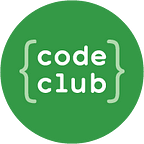What makes an impact on gender equity in STEM? Three things we can all do to help #breakthebias
It’s International Women’s Day (IWD). A time to reflect on how far we’ve come, but also how far we still have to go to see gender equity in STEM. 29% female STEM graduates is not enough.
At Code Club, we want to give all young people the same opportunity to get into coding and recent research shows that to do this, we have to start early. Girls are already starting to make decisions about STEM as early as primary school.
Here are three ways we can all help to #breakthebias (the theme for IWD in 2022) with Code Club, and ensure that girls flourish in computer science and STEM fields more broadly.
Action 1: Put coding in context
Girls often describe coding and computing as a very abstract, academic subject. However, connecting the content to a young person’s interests and everyday lives has shown to be a promising approach to shift this perception.
Ideas of how to bring this to life in your club or classroom:
- Draw on the students own interests and passions to pick a coding project for the class.
- Make cross-curricular connections between coding and other subjects. For example, you can mark World Environment Day by exploring projects in our Sustainability collection. Or talk about AI and cyber safety by getting hands on with some of our cyber security projects.
- Show the kids how they can express themselves with code. For instance, you can encourage your students to make someone special a digital card, with this Scratch project From me to you. In this project, students will think of ideas to create a digital card, choose which skills they want to make their card, and share the web address for their card.
Action 2: Give every student a sense of belonging
Sadly, computer science still suffers from the perception that it’s a career for white men, that you need to be geeky, or that you need genius-like abilities to succeed. Moreover, media and learning materials often reflect these stereotypes. This includes how topics are presented, as well as the language and visual assets used. Stereotypes like these may prevent girls and other under-represented young people from identifying with the subject.
At Code Club, we aim to embed diversity in all our coding projects, materials, and events. We do this through the fun robot graphics we use, the wide range of themed coding projects we offer, and having 50/50 representation of boys and girls involved in events.
Ideas of how to bring this to life in your club or classroom:
- Think about the ways that you promote your club. Do you have girls in the imagery?
- Try pair programming and other peer pedagogies, where students teach and learn from each other through feedback and sharing ideas. This has shown to encourage under-represented groups to get involved.
- Use role models to inspire students. This might include having young female Code Club alumnus as peer mentors. Talk with your students about the incredible role that women, like Ada Lovelace, have played in shaping modern computer science. Or this could be as simple as choosing to share online coding tips from someone like Zoe from the Scratch Team.
- Tell all students they belong in computer science.
Action 3: Be a role model and an advocate
Young people are heavily influenced by the attitudes and expectations of adults. If parents, teachers, or other adults unconsciously discourage girls from considering computer science or STEM, then girls take notice of this. Unconscious bias can show up in our language, actions, and behaviour. The good news is we all have the power to change this, to actively encourage girls to participate in STEM, pursue STEM related careers, and champion the value of learning computer science — whatever future path they choose.
Ideas of how to bring this life in your club or classroom:
- Identify your own unconscious bias that may exist.
- Have high expectations for all students.
- Encourage parental or family involvement in your club to make them part of their child’s coding and computer science journey.
- Invite female role models to come and speak with the kids in your club. To make it easier, you could even connect with them virtually.
- Encourage all students to learn computer science regardless of whether they want to become a developer or computer scientist. Computing offers them skills that they can use for self-expression or to be creative in other areas of their life.
How else can we shift the gender balance in STEM? What’s worked in your club or classroom? We’d love to hear from you.
These three actions were drawn from a series of research seminars held in 2021 by the Raspberry Pi Foundation to discuss the impact that formal and non-formal learning opportunities can have on gender balance in computing. A big thanks to the team at Raspberry Pi for their continued research and dedication to improving equity in computing. See a recording of one of these events here.
Natalie Falzon — Code Club Australia
